Dramatic changes offset any sign of diminishing returns
Ever since the groundbreaking success of 2007’s Call of Duty 4: Modern Warfare, Activision’s flagship franchise has maintained a familiar formula for prosperity, selling gangbusters year after year despite a lack of substantial iteration. Going from Infinity Ward to Treyarch, its annual release cycle has relied on an expansive multiplayer suite and a campaign geared towards linear paths and constant, bombastic set pieces. The Call of Duty series is the archetypal blockbuster video game, but its formula has quickly grown stale.
Call of Duty: Black Ops II is a game that still lives on its predecessors past endeavours, but Treyarch has also dared to look to the future. Not just with its setting, but with fundamental changes to a winning blueprint that alters our expectations of what a Call of Duty game should be.
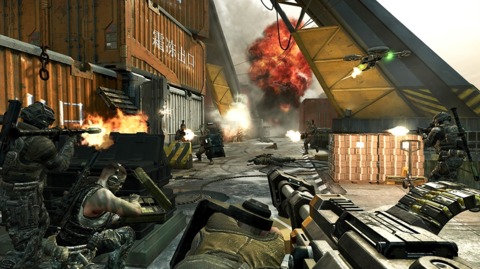
Sit down to play it for the first time and you may wonder what’s so different? Its shooting is still as snappy and satisfying as ever; you’ll follow an indestructible AI companion along a linear path that’s littered with explosions and spectacle, having control momentarily ripped away from you so that you may sample its set pieces in all their histrionic glory. It’s quintessentially COD. But edge a little further into the campaign and a compelling narrative begins to take shape that gives a rhyme and a reason for all the shooting. Those linear paths become less so, and player choice starts to effect proceedings in a way the series has never seen.
That story, for all its incongruous babble, drives the campaign with a surprising focus on character over magniloquent world ending events. Playing the original Black Opsisn’t a requisite for understanding the mechanisms of Black Ops II’s plot, but the familiarity helps as time shifts between that game’s protagonist, Alex Mason - during a decade-long period in the ‘70s and ‘80s - and his son David Mason in present day 2025. This back-and-forth is handled deftly, often intertwined with one another as the returning and aging Frank Woods explains to the younger Mason what happened to his father and why antagonist Raul Mernendez is such a dangerous threat.
Mernendez is the volatile fuel that propels the narrative to its conclusion, remaining a constant in both eras. He may be more Bond villain than anything else, but Black Ops II does a fantastic job of delving into his motivations and helping you understand why he’s doing what he is, and why he’s so focused on Mason specifically. It’s a personal story where each individual character holds a meaningful part, and everything always ties back to Menendez and the overall plot, despite the action switching between multiple characters and perspectives. It’s often compelling and tense, and lends the campaign a sense of urgency that has been absent in the series for a long time. It’s still as outlandish as ever and can get fairly nonsensical at times, but the character tale brings it down to its most base and appreciable level, urging you to find out just how it all unfolds.
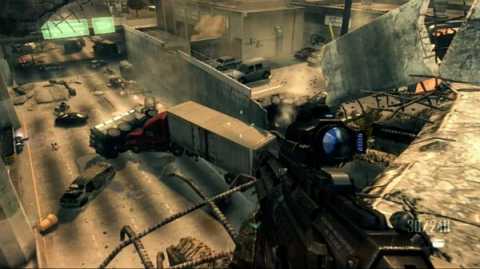
But the way it unfolds also rests on the way you play. Although it’s not obvious right away, player choice gradually begins to shape the story in some fairly substantial ways, branching to multiple paths and outcomes. At its most blatant level you’ll be asked whether to shoot a character or not, but Black Ops II also does a superb job of hiding its choices rather than telegraphing them. It’s not always a choice of one button or another; kill this man or let him live. It bleeds into the gameplay and how you perform. Certain objectives can be failed and the story will continue on, altering the trajectory of the campaign as a by-product of your actions. It inherits replayability but also riffs on the traditional COD campaign structure, forcing you to think before you do and deviate from the linear path, even if the objective markers say otherwise.
An emphasis on more wide-open areas helps with this, shifting to a multi-approach model that more closely resembles Halo or Battlefield: Bad Company. The brunt of the campaign still maintains the familiar COD formula but it’s less intruding. The big ‘FOLLOW’ markers remain but are less frequent, and the larger areas give you more room to breathe and offer multiple paths. One such level has you riding horses in Afghanistan, moving from point to point across a vast map as you tackle ground infantry, tanks and attack helicopters. It’s hardly an original approach, but for a series that has become so predictable it’s a welcome variance that will hopefully garner more attention in future additions.
However, the same cannot be said of the newly introduced Strike Force missions. These appear throughout the campaign, offering optional missions that factor in player choice and consequence, and offer a variation on the familiar gameplay. They take place on multiplayer maps, giving you multiple objectives that range from capturing and defending points, escorting a fleet of vehicles or searching buildings for a specific target.
What makes them so different is that instead of controlling one person you’re given a squad of different units to command, able to issue orders via an overhead tactical map or the traditional first-person viewpoint. It sounds interesting but it’s incredibly basic, only giving you the option to move units to a specific location, either singularly or en masse. You can’t rally soldiers to your position and they’re so inept at killing that there isn’t much of a reason to anyway. And that’s when it works. The majority of the time Strike Force is completely broken, resulting in the AI standing in place for the entire mission, despite your constant orders. It creates a situation that is unnecessarily difficult as you have to take direct control and kill waves upon waves of enemies yourself, even when it works. And despite being optional the tangible effect it has on the main campaign means you’ll want to complete them, no matter how erroneous.
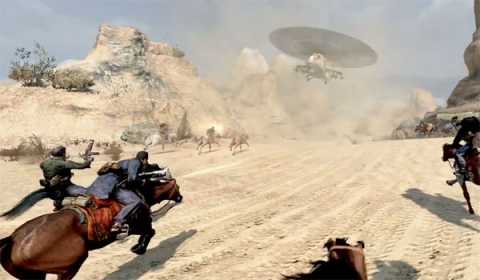
Fortunately those same multiplayer maps are put to much better use once you jump online. Black Ops II’s capacious assortment of modes and options falls in line with what we expect from the series. But like the single player campaign, Treyarch has also made some bold and fundamental changes to the way it works. Its template is still built on player progression, earning XP to level up and unlock increasingly effective weaponry, attachments, perks and so on, but the way you equip these unlocks has changed.
Dubbed the “Pick 10”, you’re now given ten slots when it comes to outfitting your own custom class. A primary weapon takes up one of these ten slots, while a secondary weapon would take another, and a perk another. Say you never use a secondary weapon and would rather have extra tactical equipment handy, or two weapon attachments on your primary instead of one? Just remove your secondary weapon and hey presto, an extra slot is freed up for you to do as you please. Wildcards take this further, altering the structure of the loadout by allowing you to use six perks instead of the standard three, or two primary weapons instead of one. But these Wildcards take up a slot as well, forcing you to lose out on an option somewhere else, striking a balance between each load out while also giving you the freedom and flexibility to cater a class to your tastes, play style and even the game mode you’re playing.
Ranging from your standard Team Deathmatch through to objective based modes like Headquarters and the returning wager matches like Gun Game and One in the Barrel (though the actual wager system is out), there’s a plethora of game modes to suit everyone. Treyarch have gone one step further, however, placing a much larger focus on rewarding teamwork. Killstreaks have been removed in favour of Scorestreaks, allowing you to call in UAVs, Care Packages and new ordnance like the aptly named Death Machine and a VTOL Warship by performing auxiliary tasks away from all the killing. Any teammate kills earned while your UAV is in the air will net you a score, while capturing points or returning the enemy team flag will score you a more substantial amount. It allows you to utilise some of the game’s more explosive tools without needing to be an expert killing machine, focusing the efforts of objective-based game modes on the objective rather than racking up a high kill/death ratio.
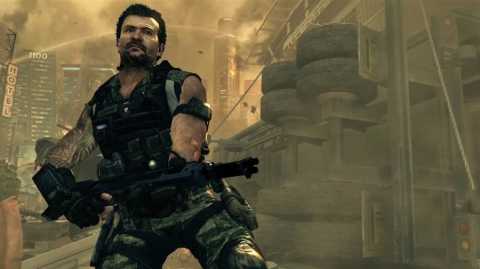
Though it’s the newly added league play that makes the most substantial changes to the traditional COD template. After playing five league games your skill level is determined and you’re placed into a division with other players who are roughly at the same level as you, able to move up or down a division depending on performance. All sense of player progression is removed with everything unlocked from the start, removing any imbalance with weapons and items and basing everything purely on player skill, levelling the playing field. You’re no longer striving for unlocks, inherently detaching the experience from everything that has made COD multiplayer what it is for the past few years. And it feels fantastic. Opening its arsenal up and competing against people at your level results in an unbounded satisfaction, shifting the multiplayer in an unfamiliar direction that’s much more about simply playing the game than being concerned with outside elements.
It helps that each map is enjoyably crafted, though the smaller of the fourteen are often riddled with spawn killing - a disappointing facet that can hopefully be ironed out as the game evolves over the next few months. Nonetheless, the future setting has allowed Treyarch to craft a much more unique universe, both in regard to its weapons and its setting, shifting ever further away from the dull limitations of “modern warfare”. It remains restrained, holding back from laser rifles and plasma pistols, instead building the kind of technology that wouldn’t be surprising come 2025. One scope marks targets making them easier to pick out, while a hefty sniper rifle can see and shoot through walls, providing a charged shot with multiple stages of fire. The sound design complements each ringing blast with some superb weapon effects that blend into the cacophony of destruction and the frenetic score.
Though where the future setting really shines is in its ability to bring out the best in the art designers. As you globe trot from one location to the next you’ll encounter dynamic environments; wading through a flooded town as buildings topple from the raging waters and overturned cars come hurting towards you. An exotic island resort houses the rich and famous, the architecture evoking hints of Dubai’s future metropolis, while smaller details plant Mason’s face on advertisements as he walks past them; Treyarch envisioning a future not too dissimilar from Minority Report. It’s a shame you spend most of your time shooting your way through these environments, never taking the time to sample the finer details. But their spectacle is no less appreciated, particularly as the game maintains the series’ silky smooth 60fps.
There are also some sharing tools that allow you to link with your YouTube account and live stream league play matches. Plus you can still access a theatre to view recent matches, edit highlight clips, take screenshots and upload these for your friends and the community to view.
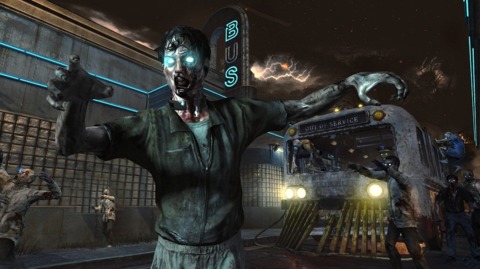
Zombies also makes a return, heralding the third incarnation of the wave-based survival mode. You still earn money by killing zombies, spending it on new weapons, ammo and opening doors to new areas. New modes like Tranzit have also been added. This throws an automated bus service onto the map, allowing you and your team to board it and travel between multiple large areas rather than being confined to a single location. Grief is also new and has you competing against another group of four players. You’re unable to directly damage each other but shooting blurs vision and you’re able to shove each other around the map, ideally into a horde of zombies. But the formula has still stagnated and grown stale. The bullet-sponge zombies are never particularly fun to fight, lacking the immediacy of the base COD gameplay, and Spec Ops still remains the superior “third mode” of this series.
That a full third of Black Ops II is substandard doesn’t seem to matter, though, because the rest of the package is so extensive and enjoyable. Those who have grown tired of the COD formula will find little reason to return here because so much of it is instantly familiar. But the story and focus on choice and consequence propel its campaign to heights the series hasn’t seen since it first took the world by storm with the original Modern Warfare. It’s still very much a game rooted in past successes, but the bold changes it makes on the campaign side shows Treyarch aren’t quite prepared to rest on their laurels; giving hope for the future of the series if they continue along this path. It’s still flawed but it holds promise, dismissing notions that the series has languished beyond repair. There’s still life left in the old dog, even if it still needs some extra invention.
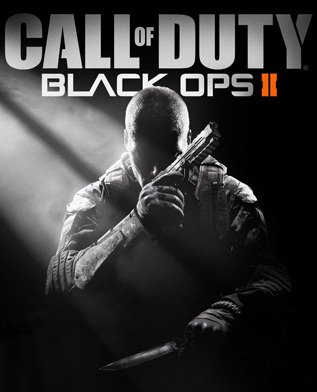
0 Comments